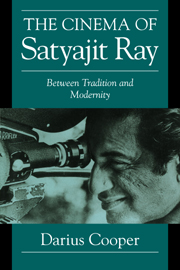Book contents
- Frontmatter
- Contents
- List of Illustrations
- Acknowledgments
- Introduction
- 1 Between Wonder, Intuition, and Suggestion: Rasa in Satyajit Ray's The Apu Trilogy and Jalsaghar
- 2 From Gazes to Threat: The Odyssean Yatra (Journey) of the Ray Woman
- 3 The Responses, Trauma, and Subjectivity of the Ray Purush (Man)
- 4 Satyajit Ray's Political Vision of the Doubly Colonized
- 5 From Newly Discovered Margins: Ray's Responses to the Center
- Notes
- Selected Bibliography
- Filmography
- Index
3 - The Responses, Trauma, and Subjectivity of the Ray Purush (Man)
Published online by Cambridge University Press: 05 June 2012
- Frontmatter
- Contents
- List of Illustrations
- Acknowledgments
- Introduction
- 1 Between Wonder, Intuition, and Suggestion: Rasa in Satyajit Ray's The Apu Trilogy and Jalsaghar
- 2 From Gazes to Threat: The Odyssean Yatra (Journey) of the Ray Woman
- 3 The Responses, Trauma, and Subjectivity of the Ray Purush (Man)
- 4 Satyajit Ray's Political Vision of the Doubly Colonized
- 5 From Newly Discovered Margins: Ray's Responses to the Center
- Notes
- Selected Bibliography
- Filmography
- Index
Summary
To Kironmoy Rahajee, Gautam Kundu, Narasingha “Ram “ Sil, and Suranjan Ganguly, who have transcended all traumas and define their subjectivity authentically, with grace, wisdom, and dignity
The Philosophical Determinant of Suffering and the Responses of the Ray Purush: Siddhartha's Response in Pratidwandi (1970)
Nirad Chaudhuri introduces us to three kinds of suffering in Hindu philosophy: “that which proceeds from the ‘self’; that which comes from external sources, things or other living creatures; and that which is inflicted by supernatural agencies and acts of God.” We are concerned primarily with suffering of the first kind proceeding from the emotions of the self, which in Chaudhuri's definition include “lust, anger, greed, delusion, fear, envy, or sadness,” and the suffering that results from “external courses which is of two kinds: that due to other living creatures or to inanimate things.” The result of this suffering leads to a conspicuous “collapse of courage and vitality” of the protagonist “placed [very distinctly] in the secular order” of the Indian landscape in which he is shown as living and functioning. Once this nadir is reached, in Hindu philosophical terms, he embraces what Chaudhuri defines as
the characteristic Hindu concept of Tamas, as the lowest of the gunas or attributes. The word tamas literally means darkness, but in Hindu thought and feeling it stands really for a very comprehensive term for all kinds of squalor – material, biological, intellectual, moral, and spiritual. Suffering in tamas was the Hindu hubris.
- Type
- Chapter
- Information
- The Cinema of Satyajit RayBetween Tradition and Modernity, pp. 134 - 176Publisher: Cambridge University PressPrint publication year: 2000



